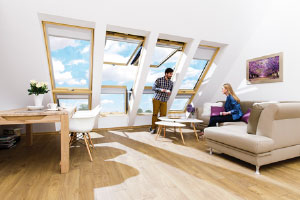Environmentally conscious building methods are becoming more popular. Here, David Knight from Roof Windows 4 You, gives his top tips for making your loft conversion more sustainable.
As sustainable and low-waste living comes to the forefront of home décor (Pinterest), homeowners and renters are looking for ways they can prioritise the environment at home. A loft conversion isn't just the perfect way to add an extra room to your property: as part of the conversion process, you can put systems in place to make your whole house more sustainable. Below, I'll be telling you how, by choosing the right building materials, insulation, and making use of your roof space, you can create a more eco-friendly loft conversion in your property.
Choose the right materials
Usually, a loft conversion is a much more effective use of materials than other extensions because they use the existing roof space to build into. So, you usually don't need to buy as many extra construction materials for the job compared to traditional extensions.
However, some designs call for the roof space to be built outward, for example if you've opted for a dormer. In this case, you'll have a choice of what materials you use in the construction process. So, you might want to pick out eco-friendly materials like FSC certified wood, recycled timber, or reclaimed brick.
You might also find a collection of roof tiles at your local reclamation yard, so it's worth looking around to give old materials a new lease of life. Alternatively, there are many environmentally friendly versions of brick and tile on the market. These can be made from natural materials, like wood fibres, or recycled items, like rubber or plastic.
Bear in mind that you might need planning permission if you're going to use any of these materials. The Town and Country Planning (General Permitted Development) (England) Order 2015 states that, during a loft conversion, the materials used in any exterior building work must be similar in appearance to  those used in the rest of the existing house. So, you might want to check with your local council first to make sure you have planning permission for your work.
those used in the rest of the existing house. So, you might want to check with your local council first to make sure you have planning permission for your work.
Make use of the roof space
When you convert your loft, you can make use of the roof space to add a few extra eco-friendly elements to your property. You could invest in solar panels, which will use energy from the sun to help generate electricity. However, at the end of 2019, the government ended their feed-in-tariff, which means you'll no longer receive money from the government for producing renewable energy. Although they might help to attract tenants, solar panels can also be quite costly to install and, because it's your tenant that pays the utilities, you're unlikely to make the money back from lower energy bills. So, solar panels might not be your best option for a rental property.
But, that's not to say your roof space can't be useful. Roof windows can not only provide a great view from your new room, but they can also help to reduce energy usage. This is because they'll let in natural light and heat from the sun, so your tenants will need to use less electricity to heat and light up the room during the day. And, because most windows now come double or triple glazed as standard, they'll help to trap the heat in, too.
Invest in insulation
In your property, approximately 25% of the heat generated by the boiler is lost through the roof, according to a report from The Green Age. This means your tenants will need to use more energy to heat their home to a comfortable temperature, increasing their carbon footprint.
As part of the conversion process, you'll need to organise having insulation fitted into the walls and floors of the space to help trap the heat in and reduce the amount that is lost through the roof. You'll need to contact a professional installer to put your insulation in for you, but you'll be able to shop around to find a supplier that suits your needs.
Most traditional insulation is made from recycled materials like glass and paper, but you can also get some that are made from natural materials like wool, hemp or wood fibres. So, you've got plenty of eco-friendly options when it comes to insulating your loft space.
Choose eco-friendly fixtures and fittings
Once the exterior building work is complete, you'll need to think about your fixtures and fittings. For example, you can use low energy LED bulbs for lighting and, if you're installing a bathroom into your loft, you can use low-flush toilets and low flow taps and showers.
You can also consider installing a rainwater harvesting system. This is a structure that uses a series of pipes (usually your existing drainage pipes) to collect rainwater from the roof and store it in a tank. This water can then be filtered and recycled for non-consumption purposes, like in toilets, reducing the need to use a mains-fed water supply. So, it might be worth installing a rainwater harvesting system if you're thinking of incorporating an en suite into the new loft conversion.
Sustainability is more important as ever for homeowners and renters. By following the tips in this guide, you can build an eco-friendly loft conversion into your property.
- Log in to post comments













